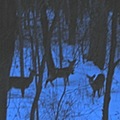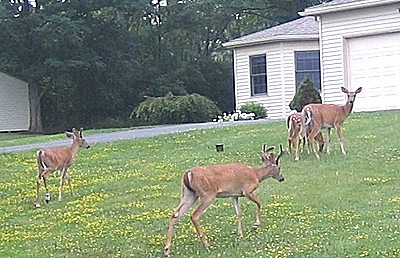- By Dan Veaner
- News
 Print
Print  With new forest growth decimated, about 35 annual auto accidents caused by deer and gardens eaten to nubs, the Village of Lansing initiated a deer population management program in 2007. Last week Village Trustees learned that while the program has been moderately successful, the deer are still winning. Seven years later Cornell University Department of Natural Resources' Dr. Bernd Blossey, who coordinates the program, said that the population is well above sustainable levels. He noted that only 15 deer had been taken so far, down from prior years at this time in the hunt. And he said that deer in the Village may pose a health threat on top of the damage they continue to wreak on village property owners.
With new forest growth decimated, about 35 annual auto accidents caused by deer and gardens eaten to nubs, the Village of Lansing initiated a deer population management program in 2007. Last week Village Trustees learned that while the program has been moderately successful, the deer are still winning. Seven years later Cornell University Department of Natural Resources' Dr. Bernd Blossey, who coordinates the program, said that the population is well above sustainable levels. He noted that only 15 deer had been taken so far, down from prior years at this time in the hunt. And he said that deer in the Village may pose a health threat on top of the damage they continue to wreak on village property owners."The deer are not dumb," Blossey said. "The ones that have survived are the smart ones that know where to hang out and not encounter hunters. All of the deer shot in the Village of Lansing so far have had ticks. None of the deer in Trumansburg have had ticks. It is an interesting perspective. We don't know the reason."
The Village of Lansing Trustees closely control hunting within its municipal borders. Firearms are strictly forbidden, and bow hunting is closely regulated. Hunters who apply to be part of the deer population management program are vetted by Blossey and his associates before given permission to join the hunt. Landowners who want to allow hunting on their properties must consult with the Village before hunting.
The program itself involves getting permission to hunt from landowners, and often their neighbors. The properties are specially posted, and hunters set up tree stands.
While many Village property owners understand the extent of the deer population and the havoc it has wreaked, especially in residential gardens and in forested areas where all new growth has been devoured, some do not want hunters near their homes. This year the state reduced the minimum amount of space between hunters and residences from 500 to 150 feet.
"The changes in discharge distances may make a difference, but it hasn't made a difference yet for us because we haven't taken advantage of it," Blossey said. "The tree stands are still in the very same locations. We have added four or five different properties to the roster of locations in the last couple of weeks. Bolton Point is the newest location, and I am in negotiations with other landowners."
One Trustee says that there is at least one known case of a Village resident putting out food for deer. That could lead to the resident being fined. With few exceptions, feeding deer and moose is illegal in New York, according to the Department of Environmental Conservation (DEC).
Over the years the program has changed in an attempt to make it more effective. In the past Blossey's group had to obtain permission from landowners each season. A recent amendment to the law says that once permission has been granted it remains in effect unless the landowner specifically terminates it.
This year Blossey's cadre of hunters has begun counting ticks found on the deer they take. Blossey said it is not entirely scientific to the point where he would trust the totals, but he said the he trusts relative numbers showing more or fewer ticks in specific areas around Tompkins County. He says it was earlier implemented in Trumansburg to help assess the health risks there.
On Monday Blossey asked the board to consider three propositions that would increase the hunting area and possibly the number of qualified hunters.
First he asked trustees to consider which Village-owned properties that could be included in the deer hunt, including a large property north of Dart Drive, and property behind the Village Public Works building, including lands around the Montessori School (not during school hours or when school events are in progress).
Trustee John O'Neil noted that Village Superintendent of Public Works John Courtney is concerned about allowing hunting on the property near Dart Drive, among other locations, because a portion of it is slated to become a Village park.
Blossey proposed that the Trustees provide guidance on which Village lands they would approve hunting on, and then he would draw a map with Code Enforcement/Zoning Officer Marty Moseley. Hartill proposed staring with the 150 foot rule.
Second, he asked the Board to consider adding a nuisance season to the regular hunting season. Blossy proposed that the additional hunting time be either during the Christmas break just after the regular hunting season and before the deer management focus area season, or after the latter, encompassing the month of February.
"This would no longer be considered hunting," Blossey said. "It would be shooting over bait at locations that landowners would approve. It would drop the numbers to where it would be acceptable in terms of lyme disease and ecological damage. It would be more easily served by focusing attention at the times when we can make a big difference."
Doing so would require a permit from the DEC, which lists 'scientific research, wildlife damage abatement, and wildlife population reduction programs' among exceptions to the 'no feeding' law, but only after obtaining a permit from the agency.
Blossey said that hunting over bait has made a big difference in the Cornell program, as well as in the Village of Trumansburg, where 50 deer were taken in four weeks.
Finally he asked the board, not for the first time, to allow cross bow hunting within the restricted Village hunt. Blossey said that current hunters in the program would not likely use crossbows, but allowing crossbows would make the hunt accessible to older hunters who no longer have the strength to pull on crossbows or compound bows.
 Deer at the entrance to the Autumn Ridge development
Deer at the entrance to the Autumn Ridge developmentAt one point Blossey and his associates estimated 300 deer in the Village of Lansing. He said he thinks there are well over 100 deer in the Village. But he noted that he had been out five times this season and only seen one deer. He said that although they estimated 100 in the Village of Trumansburg, there is evidence that estimate was conservative.
"We shot 50," he said. "Last Friday I saw 23."
Villagers are observing some improvements due to the Village hunt, but the statistics are all anecdotal, and nobody really knows how many deer actually inhabit the Village, except that there are still too many. People are still seeing a lot of damage, which indicates the program has a lot of work to do.
"Deer numbers are down across the board from what landowners tell us. There are still large groups out there, but they are in places that we have had no access to or had difficulties accessing."
"John (Courtney) tells me the same thing," said Mayor Donald Hartill. "The number of deer taken by cars this year has been a very small number."
White Buffalo, Inc., a fertility research company that has worked with the Village of Cayuga Heights on their deer sterilization program, has agreed to fly over the village in December using infra-red technology to get a count of the deer population there, as well as other municipalities around Tompkins County. Blossey said they have offered to conduct the count at no cost to the Village.
"For the first time it would give us an estimate of the deer population and where the deer are within the Village of Lansing," Blossey said.
According to the American Institute of Biological Sciences deer densities varied historically from 2-6 animals per square kilometer (km-2). But they say that under optimal conditions their population doubles every two years. Blossey told the board that 8 deer per square kilometer is sustainable, but noted that he has seen much larger groups than that.
"I saw a group of 14 last Saturday," he said. "They are bunched up in certain locations either where they know it's safe or where we can't access them."
Trustee Gerry Monaghan noted that six or eight are in the Shannon Park neighborhood, a residential neighborhood behind the Ithaca Mall, hardly optimal conditions for deer.
The board continues to work with Blossey on his first two proposals, to schedule a nuisance season and consider more Village property for inclusion in the hunt. There was no evident enthusiasm for allowing crossbow hunting.
v10i41



